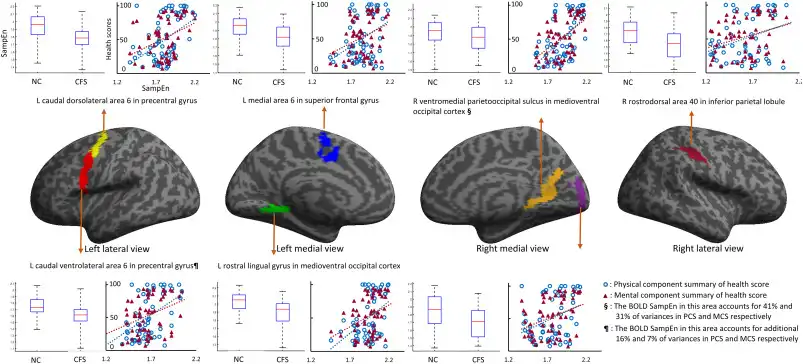Abstract
The mechanism underlying neurological dysfunction in chronic fatigue syndrome/myalgic encephalomyelitis (CFS/ME) is yet to be established. This study investigated the temporal complexity of blood oxygenation level dependent (BOLD) changes in response to the Stroop task in CFS patients.
۴۳ CFS patients (47.4 ± ۱۱.۸ yrs) and 26 normal controls (NCs, 43.4 ± ۱۳.۹ yrs) were included in this study. Their mental component summary (MCS) and physical component summary (PCS) from the 36-item Short Form Health Survey (SF-36) questionnaire were recorded. Their Stroop colour-word task performance was measured by accuracy and response time (RT). The BOLD changes associated with the Stroop task were evaluated using a 2-level general linear model approach. The temporal complexity of the BOLD responses, a measure of information capacity and thus adaptability to a challenging environment, in each activated region was measured by sample entropy (SampEn).
The CFS patients showed significantly longer RTs than the NCs (P < ۰.۰۵) but no significant difference in accuracy. One sample t-tests for the two groups (Family wise error adjusted PFWE < ۰.۰۵) showed more BOLD activation regions in the CFS, although a two sample group comparison did not show significant difference. BOLD SampEns in ten regions were significantly lower (FDR-q < ۰.۰۵) in CFS patients. BOLD SampEns in 15 regions were significantly associated with PCS (FDR-q < ۰.۰۵) and in 9 regions were associated with MCS (FDR-q < ۰.۰۵) across all subjects. SampEn of the BOLD signal in the medioventral occipital cortex could explain 40% and 31% of the variance in the SF-36 PCS and MCS scores, and those in the precentral gyrus could explain an additional 16% and 7% across all subjects.
This is the first study to investigate BOLD signal SampEn in response to tasks in CFS. The results suggest the brain responds differently to a cognitive challenge in patients with CFS, with recruitment of wider regions to compensate for lower information capacity.

